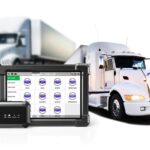It’s a common question among automotive enthusiasts and DIYers: can you directly extract a tachometer signal from the OBD2 port? The answer is a bit more complex than a simple yes or no. Let’s delve into the intricacies of OBD2 systems and tachometer signals.
The On-Board Diagnostics II (OBD2) system in modern vehicles communicates using a Controller Area Network (CAN) bus. Think of it as a sophisticated digital network, similar to USB or Ethernet in computers. Data transmitted over the CAN bus isn’t in the form of readily accessible analog or PWM signals. Instead, it’s digitally encoded information that requires interpretation. To access and understand this data, you need specialized hardware, much like an OBD2 scanner, which is equipped with a microcontroller capable of CAN communication and data decoding.
Directly “sniffing” a tachometer signal as a distinct, usable signal from the OBD2 port is not feasible. The data stream needs to be processed and decoded to extract specific parameters like RPM, which could then be used as a tachometer signal.
However, there might be alternative approaches to obtain a tachometer signal. One option is to investigate the wiring leading to the instrument cluster. The tachometer within your gauge cluster needs a signal to operate. This signal, prior to reaching the tachometer itself, could potentially be either a Pulse Width Modulation (PWM) digital signal or an analog signal. If you can identify the correct wire in the harness behind the instrument cluster, you might be able to tap into this signal. The challenge lies in determining if this signal is externally accessible or buried within the cluster’s internal circuitry.
Another avenue to explore is utilizing a Bluetooth OBD2 data transmitter. These devices are designed to wirelessly transmit OBD2 data, often to smartphones running dedicated apps that decode and display vehicle information. If your data logger has Bluetooth capabilities, it might be compatible with certain OBD2 transmitters. This setup would allow you to indirectly access RPM data, which functions as your tachometer signal, by leveraging the decoded information from the OBD2 system.
In conclusion, while directly obtaining a dedicated “Obd2 Tachometer Signal” in a traditional analog or PWM form isn’t possible due to the CAN bus nature of OBD2, alternatives exist. Exploring the instrument cluster wiring or using Bluetooth OBD2 adapters in conjunction with a compatible data logger offers potential solutions for acquiring tachometer-related data from your vehicle.
